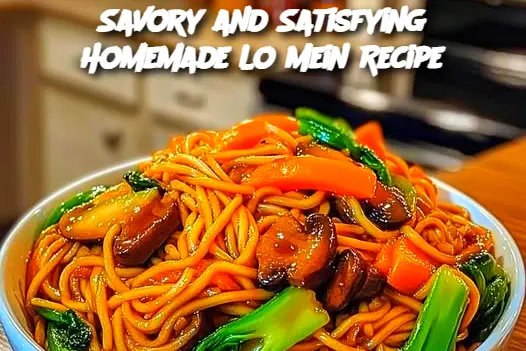Prepare the Stir-Fry Vegetables: In a large pan or wok, heat the sesame oil over medium-high heat. Add the onion, bell pepper, and carrot. Stir-fry for about 3-4 minutes until the vegetables begin to soften but still retain some crunch. Add the broccoli, garlic, and grated ginger, and continue to stir-fry for another 2 minutes until fragrant.
Make the Sauce: In a small bowl, whisk together soy sauce, oyster sauce, hoisin sauce, rice vinegar, brown sugar, cornstarch, and water. Stir until the sugar dissolves and the cornstarch is fully dissolved.
Combine the Noodles: Add the cooked noodles to the pan with the vegetables. Pour the sauce over the noodles and vegetables. Toss everything together, ensuring the noodles are evenly coated with the sauce. Cook for another 2-3 minutes, allowing the sauce to thicken and the noodles to absorb the flavors.
Serve: Transfer the Lo Mein to serving plates. Garnish with chopped green onions, sesame seeds, and chili flakes if desired. Serve immediately while hot.
Tips for Serving and Storing:
Serving: Lo Mein pairs well with a side of dumplings, spring rolls, or a light soup. To make it a complete meal, you can add protein like grilled chicken, shrimp, tofu, or beef.
Storing: Leftover Lo Mein can be stored in an airtight container in the fridge for up to 2-3 days. Reheat it in a skillet or wok over medium heat with a splash of water or soy sauce to keep the noodles moist.
Noodles: Fresh noodles tend to hold up better than dried ones in stir-fry dishes, but both work well. If using dried noodles, make sure to avoid overcooking them so they don’t become mushy.
Variants:
Vegetarian Lo Mein: For a completely plant-based version, simply skip the oyster sauce and use mushroom or vegetable-based sauce. Add more vegetables like snap peas, baby corn, or mushrooms for a hearty dish.
Protein Options: Add cooked chicken, shrimp, beef, or tofu to your Lo Mein for a boost of protein. Stir-fry the protein separately and add it to the noodles at the end for best results.
Spicy Lo Mein: For a spicier kick, add chili paste, sriracha, or red pepper flakes to the sauce. You can also top with fresh chopped chilies for an extra fiery bite.
FAQ:
Q1: Can I make Lo Mein without sesame oil? A1: Yes, you can substitute sesame oil with vegetable oil or canola oil. However, sesame oil adds a distinctive nutty flavor that enhances the dish, so it’s recommended for the best taste.
Q2: What can I use instead of Lo Mein noodles? A2: If you can’t find Lo Mein noodles, you can use spaghetti, egg noodles, or even soba noodles as a substitute. Just be sure to adjust the cooking time based on the type of noodle you choose.
Q3: Can I make the sauce ahead of time? A3: Absolutely! You can prepare the sauce in advance and store it in a sealed container in the fridge for up to a week. When ready to use, simply whisk it again before pouring it over the noodles.
Q4: How can I make Lo Mein gluten-free? A4: To make this dish gluten-free, use gluten-free soy sauce (or tamari), and ensure the noodles are gluten-free (rice noodles or gluten-free spaghetti work well). Replace the oyster sauce with a gluten-free alternative like mushroom sauce.
Q5: Can I freeze leftover Lo Mein? A5: While Lo Mein can be stored in the fridge for a few days, it’s not the best dish for freezing due to the texture of the noodles. If you do freeze it, reheat carefully to avoid overcooking the noodles.
This homemade Lo Mein recipe offers a perfect balance of flavors and textures, making it an ideal dish for any occasion. Whether you enjoy it vegetarian or with added protein, the fresh ingredients and delicious sauce will make this one of your favorite stir-fry meals. Enjoy the versatility of Lo Mein and feel free to experiment with different vegetables and proteins for a personalized touch!
ADVERTISEMENT

